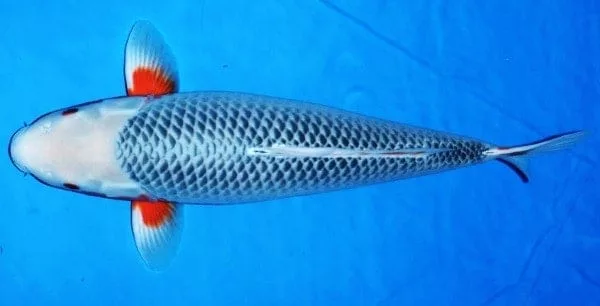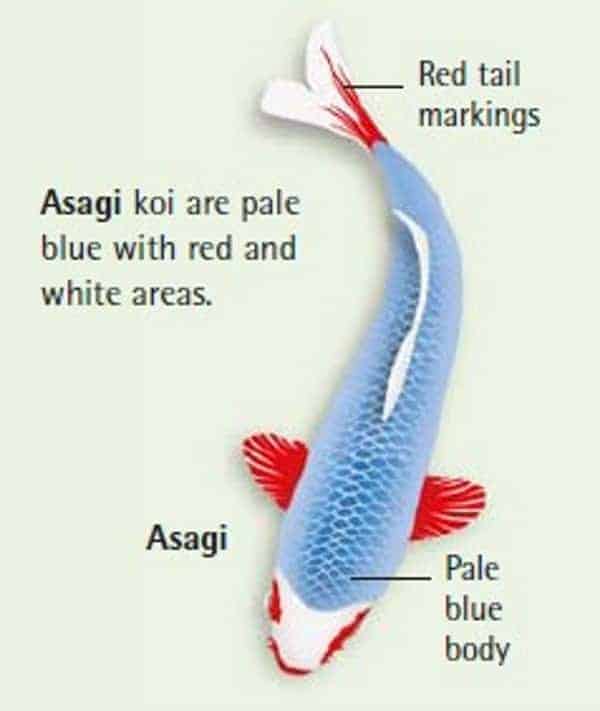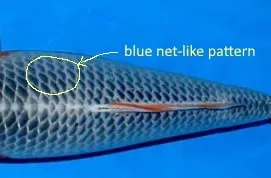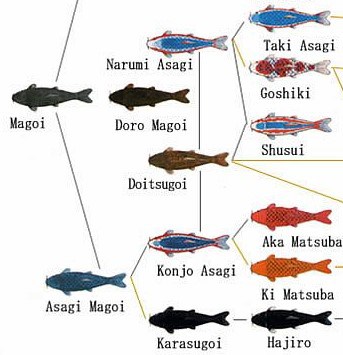
Distinctive Features of the Asagi Koi:
The Asagi koi displays two striking features:
- Vibrant Blue or Indigo Body: The Asagi boasts a stunning bluish or indigo body hue, a defining characteristic of the breed.
- Red Pigmentation at Pectoral Fins: Known as Motoaka, this red coloration at the base of the pectoral fins adds to the beauty of both Asagi and Shusui varieties, as they share a common ancestry.
The Enduring Elegance of the Asagi:
Among the most ancient koi breeds is the Asagi. Renowned for its stoic and subdued nature, some even consider it an acquired taste.
Despite being fully scaled and lacking metallic markings, the Asagi’s long history is sometimes overshadowed by its resemblance to the wild black carp, Magoi. Some hobbyists perceive them as unrefined or dull, not “proper” koi. Indeed, their understated elegance stands in contrast to the brilliantly colored Showa or flashy Hikariutsuri varieties. However, their quiet charm provides a beautiful counterpoint to their more vibrant pond mates. Additionally, Asagi have the potential to grow remarkably large.
Origins and Varieties:
In Japan, three Magoi types are recognized. The Asagi Magoi, with its bluish back, reticulated pattern, and hints of red on the cheeks and fins, is the ancestor of all modern koi. Approximately 160 years ago, two key mutations arose from this proto-koi: the Konjo and the Narumi Asagi. While valuable in the development of Matsuba koi, the dark Konjo variety is mainly considered food fish due to its lack of aesthetic appeal. However, the Narumi Asagi, along with its Doitsu counterpart Shusui, forms a recognized judging category.

The Asagi Koi: A Timeless Beauty
The Asagi koi is one of the oldest and most recognized koi breeds, gracing ponds for over 160 years. While some find their subdued beauty an acquired taste, their elegance and historical significance have made them a popular choice for koi enthusiasts.

Distinctive Features:
- Blue-scaled pattern: The Asagi’s signature look is a mesmerizing net-like pattern of blue scales across its back. This pattern is particularly valued for its symmetry and clarity. Opens in a new windowkoistory.comAsagi koi with bluescaled pattern
- Red accents: The blue is complemented by subtle splashes of red on the fins, gill plates, and sometimes the belly. This red coloration adds a touch of warmth and vibrancy to the overall aesthetic.
- Doitsu and Hi variations: Asagi koi come in a few variations. Doitsu Asagi, or Shusui, have a metallic, scaleless appearance. Hi Asagi, on the other hand, have a more intense red coloration that overlays the blue pattern. Opens in a new windowchevron_rightwww.koi-hv.deDoitsu Asagi koi (Shusui)
- Taki Asagi: Another interesting variation is the Taki Asagi, characterized by a blue pattern that extends down its sides and onto its belly, resembling a waterfall. Opens in a new windowpondinformer.comTaki Asagi koi
A Symbol of Tranquility and Strength
The Asagi koi’s calm demeanor and understated beauty make it a symbol of tranquility and inner strength. Their presence in a pond adds a touch of serenity and sophistication to any outdoor space.
Caring for Asagi Koi:
Asagi koi are relatively hardy and can thrive in a variety of pond conditions. However, they do require proper care and maintenance, including:
- Adequate pond size and filtration
- Balanced diet
- Appropriate temperature range
- Regular water testing and maintenance
With proper care, Asagi koi can live for many years, bringing their timeless beauty and graceful presence to your pond.

shisui versus asagi koi
tosai asagi koi
Why are some Asagi koi grey and not white?
Asagi are one of the oldest and most beautiful koi breeds. While many have a stunning blue-grey base with red markings, some individuals show a different pattern: a line of white scales separating the red and blue areas. However, even within this “Shirogami” type of Asagi, it’s common for the head to have a muted, greyish tone.
So, if your young Asagi’s scales seem less vibrant, don’t fret! This grey head color is normal and shouldn’t impact their beauty or development.
How to Judge Asagi
When young, the Asagi koi’s pectoral fins are uniformly red. As they mature, the fins gradually lose their red color, starting from the tip. Over time, the red remains only at the base, covering roughly one-third to one-half of the fin. This “Motoaka” is prized for its aesthetic balance, but its presence isn’t essential for a beautiful Asagi.
Even more important than the body is the head. A distinctive, pure white head is crucial. Any dark spots (“Jyami”) or yellowing are considered flaws. The crystal-clear head beautifully highlights the blue scales on the body.
The scales themselves should line the body perfectly, with no gaps or irregularities. An ideal Asagi has five to six evenly spaced rows of scales extending from the dorsal fin, forming clean lines along the sides up to the lateral line. While young koi may not yet have the characteristic netting pattern, it becomes a stunning focal point as they mature, with variations in blue adding further depth and beauty.
asagi koi history
The history of Asagi
Narumi: This name likely originates from the town of the same name in Ichi Prefecture, where a local fabric design is said to have mirrored the patterns on these koi’s backs.
Fascinatingly, Asagi koi popped up across Japan, not just in Niigata. This occurred during a period when people were captivated by mutant fish. Instead of being seen as food, these unique specimens were preserved and bred out of curiosity, long before koi were valued for their beauty.

Meet the Asagi, one of the original “blue koi!” Dating back over 200 years, the Asagi is a stunning koi variety bred from the Magoi, a common black carp. The Magoi served as the ancestor for many koi variations, thanks to its ability to mutate and produce different colors and patterns.
narumi asagi koi

One type of koi, the narumi asagi, boasts a deep blue background of uniform scales adorned with a net-like pattern of lighter blue. This strain forms the foundation for most modern asagi.
Modern Asagi
While Asagi Koi tend to breed fairly true, many average examples flood the market each year. This can give newcomers a negative impression of the variety, since truly exceptional specimens are rare.
Ideally, the Asagi’s back should be covered in uniform scales, pale blue at the base where they meet the skin and edged with a darker shade. The key point is that the lighter base should come first, not the darker edge as sometimes wrongly described. The sharper the contrast between these two tones, the more stunning the koi becomes.
The Captivating Asagi Koi: A Blend of Tradition and Beauty
In the mesmerizing world of koi fish, the Asagi stands out as a true masterpiece. Its unique blend of elegance and subtle beauty has captured the hearts of collectors and enthusiasts worldwide.
A Timeless Lineage:
The Asagi, also known as “Asa fish,” holds a special place in koi history. Tracing its roots back to 1850, it’s one of the oldest and most revered breeds. Its name, “Asagi,” echoes the serene blue hues of its coloration, reminiscent of the Japanese term for “setting sun.”
A Tale of Two Colors:
The Asagi is instantly recognizable by its signature pattern. A light blue or gray-blue base is adorned with a mesmerizing net-like reticulation of dark blue lines, echoing its carp ancestry. This pattern seamlessly blends with vibrant red or orange markings on the back and head, creating a captivating contrast.
Rarity and Allure:
The Asagi’s exclusivity adds to its charm. Aoki Koi Farm, renowned for its dedication to exceptional koi breeding, is a haven for Asagi enthusiasts. Their expertise ensures Asagi specimens of unparalleled quality and breathtaking beauty.
A Universe of Variations:
The Asagi family offers a mesmerizing array of subtypes. From the majestic Kage Koi to the striking Doitsu Asagi, each variety boasts its own unique characteristics. Doitsu Asagi, for example, features a scaleless body with prominent dorsal scales, adding an intriguing texture to its appearance.
Subtle Elegance, Enduring Appeal:
While some koi boast bold patterns, the Asagi’s allure lies in its understated elegance. The harmonious balance of blues and fiery hues speaks to discerning tastes and a refined appreciation for beauty. It’s an art form to be savored, not simply admired.
A Tapestry of Culture and Color:
The world of koi fish is a tapestry of cultural significance, and the Asagi embodies this beautifully. Its tranquil blue hues echo the serenity of nature, while its intricate patterns reflect the meticulous dedication of generations of koi breeders.
For Every Enthusiast:
Whether you’re a seasoned collector or new to the enchanting world of koi, the Asagi deserves a place in your pond. Its timeless beauty, historical significance, and mesmerizing color combinations leave a lasting impression.
Beyond Blue: Pushing the Boundaries:
The Asagi challenges conventional notions of koi color. Its presence inspires breeders to explore the possibilities of blue koi varieties, pushing the boundaries of genetics and selective breeding.
More Than Just Beauty:
The Asagi’s cultural significance adds another layer to its allure. Its name evokes tranquility and grace, reflecting the essence of the calm waters it calls home.
Subtypes and Splendor:
The Asagi family unveils even more beauty through its subtypes. Hi Asagi, for example, amplifies the red markings, creating a stunning visual spectacle. The possibilities seem endless, offering boundless exploration for koi enthusiasts.
Beauty in Diversity:
Remember, beauty is subjective. While the Asagi may captivate some, others may find their hearts stolen by the striking patterns of the Narumi Asagi or the serene elegance of the Yuki Asagi. Embrace the diversity and the unique charm each breed offers.
Finding Your Asagi:
When seeking Asagi Koi, trust reputable sources. Aoki Koi Farm continues to be a preferred choice for collectors worldwide, thanks to their unwavering commitment to quality and excellence.
A Rare Gem, a Worthy Investment:
Asagi Koi’s exclusivity comes with a price tag. Be prepared to invest in this rare and highly sought-after breed, appreciating its value as a timeless masterpiece of nature and human artistry.
A Lasting Enchantment:
In conclusion, the Asagi Koi is more than just a fish; it’s an embodiment of elegance, tradition, and enduring beauty. Its captivating presence continues to inspire and enthrall koi enthusiasts worldwide. So, dive into the captivating world of koi, explore its wonders, and let the Asagi Koi transport you to a realm of serenity and fascination.
learn more about different types of koi
Asagi Koi: A Dive into Elegance and Tradition
Introduction ????
Welcome to the mesmerizing world of asagi koi, a unique and enchanting variety that has captured the hearts of koi enthusiasts worldwide. In this article, we will delve into the origins, distinctive features, care requirements, and cultural significance of asagi koi, exploring why these majestic creatures hold a special place in the realm of ornamental fish keeping.
Origins and History ????
Asagi koi, with its roots deeply embedded in Japanese culture, has evolved over the years to become a symbol of elegance and beauty. Tracing its history, we uncover the fascinating journey of this breed from its humble beginnings to its prominence in modern koi keeping.
Distinctive Features ????
The allure of asagi koi lies in its distinctive coloration and patterns, complemented by unique scales and body structures. Let’s unravel the mysteries behind the captivating appearance that sets asagi koi apart from other koi varieties.
Caring for Asagi Koi ????
Creating an ideal environment for asagi koi requires careful consideration of tank conditions, feeding routines, and health precautions. Discover the secrets to ensuring the well-being and vibrancy of these exquisite fish in your own aquatic haven.
Breeding Asagi Koi ????
The intricacies of asagi koi reproduction and the art of selective breeding play a crucial role in maintaining the purity and excellence of the breed. Learn about the fascinating journey from spawning to nurturing the next generation of asagi koi.
Asagi Koi in Traditional Japanese Art ????
Explore the rich symbolism attached to asagi koi in Japanese culture and their prominent presence in traditional art and literature. Uncover the meanings behind the depictions of these majestic fish and their role in conveying cultural significance.
Asagi Koi Varieties ????
Dive into the world of asagi koi subtypes and variations, each boasting unique characteristics that make them stand out. From the classic Asagi to the Doitsu Asagi, discover the diverse array of asagi koi varieties.
Challenges in Asagi Koi Keeping ⚠️
Owning asagi koi comes with its share of challenges, from health concerns to maintaining water quality. Gain insights into common issues faced by asagi koi owners and valuable tips for overcoming these hurdles.
Asagi Koi and Feng Shui ☯️
Explore the intersection of asagi koi and Feng Shui, as we delve into the beliefs and practices associated with these magnificent fish. Learn about the auspicious placement of asagi koi to invite positive energy into your living space.
Global Appreciation ????
Witness the global appreciation for asagi koi as they make waves in international koi competitions. Discover how these Japanese treasures have transcended cultural boundaries, captivating the hearts of koi enthusiasts around the world.
Sustainable Practices in Asagi Koi Keeping ????
As the world embraces eco-friendly practices, discover sustainable approaches to asagi koi keeping. Uncover responsible ownership practices and conservation efforts aimed at preserving the beauty of asagi koi for generations to come.
Asagi Koi Events and Shows ????
Immerse yourself in the world of asagi koi through annual events and shows that celebrate the beauty of these fish. Learn about opportunities to participate, engage with fellow enthusiasts, and marvel at the finest asagi koi specimens.
Online Communities and Resources ????
Connect with like-minded individuals in online forums and groups dedicated to asagi koi enthusiasts. Access educational resources to deepen your understanding of asagi koi care, breeding techniques, and the latest developments in the koi keeping community.
Future Trends in Asagi Koi Keeping ????
Look ahead to the future of asagi koi keeping, where technological advancements and emerging trends promise exciting developments. Stay informed about the latest innovations shaping the world of asagi koi.
Conclusion ????
In conclusion, asagi koi stand as not just ornamental fish but as living works of art that bring elegance and tradition to any aquatic setting. Whether you’re a seasoned koi enthusiast or a newcomer to the world of ornamental fish, the allure of asagi koi is undeniable. Take a plunge into the captivating world of these majestic fish and witness the beauty that unfolds beneath the water’s surface.
Frequently ask questions FAQs
Can asagi koi be kept in outdoor ponds?
Yes, asagi koi are well-suited for outdoor ponds, provided the conditions mimic their natural habitat.
What is the lifespan of an asagi koi?
With proper care, asagi koi can live for several decades, some even reaching over 50 years.
Are there specific dietary requirements for asagi koi?
Asagi koi thrive on a balanced diet of high-quality koi pellets, supplemented with occasional treats like live or frozen food.
How can I identify the different varieties of asagi koi?
Each variety has distinct characteristics; consulting with experienced breeders or referring to reputable resources can help in identification.
What is the significance of asagi koi in Japanese art?
Asagi koi hold cultural significance, symbolizing perseverance, strength, and good fortune in various traditional Japanese art forms.
You may also like
- https://www.giobelkoicenter.com/koi-fish-nft/
- https://www.giobelkoicenter.com/goshiki-koi/
- https://www.giobelkoicenter.com/kigoi-koi/
- https://www.giobelkoicenter.com/ogon-koi-fish/
- https://www.giobelkoicenter.com/most-expensive-koi-fish/